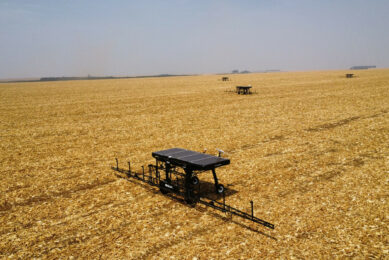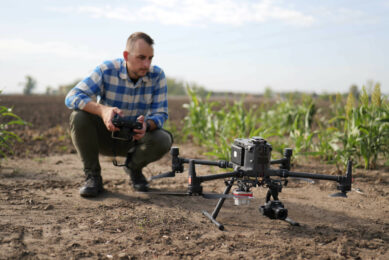Tiny Flapper Drone takes flight in greenhouse

Researchers in the Netherlands are investigating the merits of using a tiny, bio-inspired autonomous flapping drone for horticultural and agricultural operations.
Developed by the Technical University Delft, the Flapper Drone mimics bird and insect flight by flapping its wings up to 12 times/second. It weighs from just 7gm up 100gm and, like a dragonfly, it has four wings that provide flight and stability as well as allow it to manoeuvre by moving at different speeds and directions.
Autonomous control through an on-board computer is essential because a human pilot cannot respond fast enough to steer the drone, says its developers. This provides full control of the body rotations (roll, pitch and yaw) and the thrust force produced by the wings.
Altering the motion and geometry of the individual pairs of wings enables the agile Flapper Drone to fly in any direction. It has vertical take off and landing, hover, fly forwards, backwards, sideways and rotate on the spot.
A big advantage of the bio-inspired design, which uses its flapping wings to fly, is it has a significantly longer battery life than an equivalent drone using rotors.
Horticultural applications
Under development at TU Delft for the past ten years, the Flapper Drone is already being used commercially by its start-up company Flapper Drones BV, for shows and displays as well as research.
It’s size and weight also makes it an attractive option for use in crops grown in greenhouses, which is why the company and TUDelft decided to collaborate with Wageningen University and Research to explore its agricultural applications.
Together with the Wageningen, the team organised a demonstration and workshop to gauge interest in the greenhouse market. Erik Pekkeriet, programme manager for Agri-Food Robotics at Wageningen University & Research, says he sees potential for the Flapper Drone in greenhouses and undercover cropping.
Also watch this video: “Flapper drone” flies like a butterfly in greenhouse
“Its high level of manoeuvrability and light weight, make the Flapper Drone ideally suited to working near delicate crops and flowers, because it won’t damage them if it accidentally hits them. Similarly, it poses little risk to people working inside as well.
“It also suits recent changes in greenhouse growing, with higher levels of C02 and more light producing larger plants with denser vegetation. Here it could be good for carrying out monitoring a wide range of conditions, without risk of damaging plants and flowers,” he explains.
Depending on what sensors are fitted, the Flapper Drone could be used to monitor a range of parameters, such as temperatures at different heights, germination or ripening of fruit, even pollination. However, its size means it has a limited payload and, with a relatively short flight time, it does have its limitations.
“The motion in flight is not particularly stable – unlike a drone,” says Mr Pekkeriet. “This means I don’t think it would be suitable, in the short term, for use with precise vision systems and because it is very vulnerable to wind, it’s definitely restricted to inside use.”
From his experience of seeing it at work, in a greenhouse at the demonstration, Mr Pekkeriet reckons the Flapper Drone offers a number of advantages, as well as a few drawbacks. “There is a place for this type of drone that can operate efficiently inside, without risk to plants or people,” he adds.
Flapper Drone summary
Advantages
- Gentle and natural operation
- Little risk of damaging plants
- Continues to fly if in collision with plants
- Safe to use near people
- Fast and efficient in horizontal wing mode
- High energy efficiency – consumes less energy than a rotor drone
Drawbacks
- Shakes in operation could limit use with vision systems
- Limited payload related to size
- Highly sensitive to wind
- Limited flight time
Join 17,000+ subscribers
Subscribe to our newsletter to stay updated about all the need-to-know content in the agricultural sector, two times a week.



